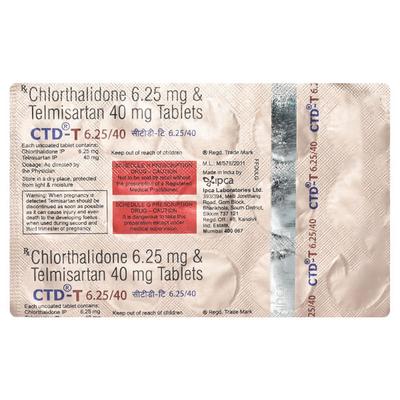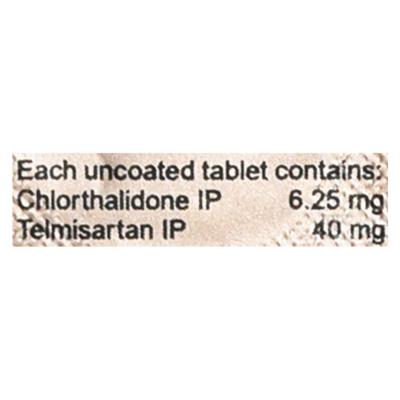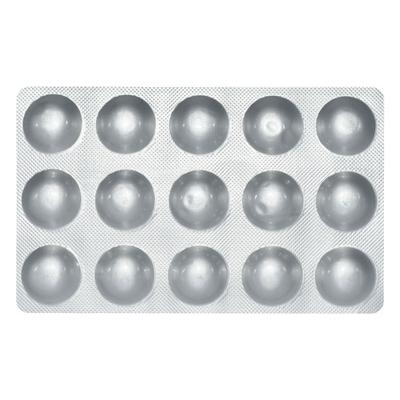

Netmeds First Membership
Quick Links
Introduction About CTD T 6.25/40MG TABLET
CTD T 6.25/40MG TABLET is used to manage hypertension (high blood pressure) in affected individuals when monotherapy with chlorthalidone or telmisartan becomes inadequate to control the condition. It is also used as initial therapy in patients who are indicated for multiple drug therapy to control high blood pressure. It is a combination of Chlorthalidone and Telmisartan which belongs to the group of medicines called Diuretics and Angiotensin II receptor blockers, respectively.
CTD T 6.25/40MG TABLET is not recommended for use in patients who are allergic to chlorthalidone, telmisartan, and/or any sulphonamide-derived medicines. It is also not recommended for use in patients suffering from anuria and severe liver impairment. Before taking the medicine, inform your doctor if you have liver problems, kidney problems and/or heart problems (such as congestive heart failure).
CTD T 6.25/40MG TABLET is not recommended for use during pregnancy and in women planning for pregnancy. It is also not recommended for use in breastfeeding women since it passes through breast milk. It should be used with caution in children and adolescents (aged 6 to 18 years) and in elders (aged 65 years and above). The most common side effects are back pain, sore throat, nausea, abdominal pain, indigestion, diarrhoea, and/or headache. Consult your doctor if any of these symptoms worsen.
Uses Of CTD T 6.25/40MG TABLET
- Used to manage hypertension
How CTD T 6.25/40MG TABLET Works
CTD T 6.25/40MG TABLET helps to lower blood pressure, where telmisartan works by blocking angiotensin (a hormone responsible for regulating blood pressure and maintaining fluid balance in the body) which leads to relaxation of blood vessels and Chlorthalidone works by removing extra water and certain electrolytes from the body which leads to relaxation of blood pressure and improved blood flow thus reducing high blood pressure in affected individuals.
How to use CTD T 6.25/40MG TABLET
- Take CTD T 6.25/40MG TABLET as advised by your physician
- Swallow the medicine with a glass of water. Do not crush or chew the medicine
- Your doctor will decide the correct dose and duration for you depending on your age, body weight and disease condition
Side Effects Of CTD T 6.25/40MG TABLET
Common side effects of CTD T 6.25/40MG TABLET:
- back pain
- abdominal pain, indigestion
- diarrhoea
- headache, dizziness, feeling weak
- dry mouth
Stop taking CTD T 6.25/40MG TABLET and contact your doctor immediately if you experience any of the following side effects:
- Signs of hypokalaemia (low potassium level in blood) such as muscular weakness, racing heartbeat, extreme tiredness
Warning & Precautions
Pregnancy
Consult your doctorIf you are pregnant women, think you may be pregnant, or are planning to have a baby, ask your doctor for advice before taking this medicine.
Breastfeeding
Consult your doctorIf you are a breastfeeding women, ask your doctor for advice before taking this medicine.
Kidney
Use with CautionCTD T 6.25/40MG TABLET should be used with caution in patients undergoing haemodialysis and in patients with kidney problems such as decreased renal function, severe renal impairment, and nephrogenic diabetes insipidus.
Liver
Consult your doctorCTD T 6.25/40MG TABLET is not recommended for use in patients with severe liver impairment. It should be taken with caution in patients with liver disease such as mild to moderate hepatic impairment.
Allergy
ContraindicatedDo not take CTD T 6.25/40MG TABLET if you are allergic to chlorthalidone, telmisartan or any other ingredients of this medicine.
Heart Disease
Use with CautionCTD T 6.25/40MG TABLET should be used with caution in patients with heart diseases such as congestive heart failure.
Use In Pediatrics
Use with CautionCTD T 6.25/40MG TABLET should be used with caution in children and adolescents (aged 6 to 18 years).
Use In Geriatrics
Use with CautionCTD T 6.25/40MG TABLET should be used with caution in elderly patients (aged above 65 years).
Others
CTD T 6.25/40MG TABLET is not recommended for use if you:
- have anuria (failure of kidneys to produce urine)
Interactions
A. Drug-Drug interactions:
Before taking CTD T 6.25/40MG TABLET, inform your doctor if you are taking any of the following medicine:
- Anti-hypertensive agents (Ex. aliskiren, ramipiril, guanethidine, methyldopa)
- Cardiac glycosides (Ex. Digoxin)
- Anti-maniac agents (Ex. Lithium)
- Selective COX-2 inhibitors (Ex. celecoxib, indometacin)
- Anti-diabetics (Ex. metformin, glibenclamide, insulin)
- Anti-cholinergic agents (Ex. atropine, biperiden)
- Calcium salts, Vitamin D
- Immunosuppressants (Ex. Cyclosporin)
- β-blockers (Ex. acebutolol, atenolol)
- Vasodilators (Ex. benazepril, lisinopril)
- calcium antagonists (Ex. amlodipine, diltiazem)
- ACE inhibitors (Ex. benazepril, captopril)
- Anti-lipidemic agents (Ex. Cholestyramine)
- Corticosteroids (Ex. prednisolone)
- Beta-2 agonists (Ex. salbutamol, terbutaline)
- Antifungals (Ex. Amphotericin)
- Triterpenoids (Ex. Carbenoxolone)
- Cardiac glycosides (Ex. Digitalis)
- Xanthine oxidase inhibitor (Ex. Allopurinol)
- Adamantanes (Ex. Amantadine)
- Benzothiadiazine (Ex. Diazoxide)
- Cytotoxic agents (Ex. cyclophosphamide, methotrexate)
B. Drug-Food interaction:
Avoid having very strict low-salt diet while taking CTD T 6.25/40MG TABLET since it may cause undesirable effects.
Overdosage:
If you or anyone else accidentally take too much of the medicine, consult your doctor immediately or visit the nearby hospital. Symptoms of overdose are low blood pressure, dizziness, fast heart rate, slow heart rate, nausea, sleeplessness, hypovolaemia (low blood volume), and electrolyte imbalances (associated with an irregular heartbeat and muscle spasms).
Synopsis
| Drug | : | Chlorthalidone, Telmisartan |
| Pharmacological Category | : | Diuretics, Angiotensin II receptor blockers |
| Therapeutic Indication | : | Hypertension |
| Dosage Forms | : | Tablet |
More Information
FAQs About CTD T 6.25/40MG TABLET
Q: What is CTD T 6.25/40MG TABLET used for?
A: CTD T 6.25/40MG TABLET is used to manage essential hypertension (high blood pressure) in affected individuals when monotherapy with chlorthalidone or telmisartan becomes inadequate to control the condition.
Q: How does CTD T 6.25/40MG TABLET works?
A: CTD T 6.25/40MG TABLET helps to lower blood pressure, whereas telmisartan works by blocking angiotensin (a hormone responsible for regulating blood pressure and maintaining fluid balance in the body) which leads to the relaxation of blood vessels and chlorthalidone works by removing extra water and certain electrolytes from the body which leads to relaxation of blood pressure and improved blood flow thus reducing high blood pressure in affected individuals.
Q: How is CTD T 6.25/40MG TABLET taken?
A: Take CTD T 6.25/40MG TABLET as advised by your physician. Swallow the medicine with a glass of water. Do not crush or chew the medicine. Your doctor will decide the correct dose and duration for you depending on your age, body weight and disease condition.
Q: What are the side effects of CTD T 6.25/40MG TABLET?
A: The most common side effects of taking CTD T 6.25/40MG TABLET are back pain, sore throat, nausea, abdominal pain, indigestion, diarrhoea, and/or headache. Consult your doctor if any of these symptoms worsen.
Q: What happens if you take more CTD T 6.25/40MG TABLET than the required dose?
A: If you or anyone else accidentally take too much of CTD T 6.25/40MG TABLET, consult your doctor immediately or visit the nearby hospital. Overdose symptoms are low blood pressure, dizziness, fast heart rate, slow heart rate, nausea, sleeplessness, hypovolaemia (low blood volume), and electrolyte imbalances (associated with irregular heartbeat and muscle spasms).
References
1. KD Tripathi. Drugs Affecting Renin - Angiotensin System & Plasma Kinins and Antihypertensive Drugs. Essentials of medical pharmacology. Seventh edition. 2013. Page – 507,559.
2. Suresh V Sagarad, Sudha Biradar Kerure, Chaitanya Kumar S, and Ramakrishna MR. Sagarad Kerure SB, Kumar S C, Mr R. The Antihypertensive Efficacy of Chlorthalidone and Telmisartan in Indian Hypertensive Patients who were Uncontrolled with Hydrochlorothiazide and Telmisartan Combination – A prospective and an open label study. NIH National Library of Medicine. National center for biotechnology Information. February 2013. [Accessed on 10th October 2022] click here
3. Mary M. Stephens, Beth A. Fox, and Lisa Maxwell. Therapeutic Options for the Treatment of Hypertension in Children and Adolescents. NIH National Library of Medicine. National Center for Biotechnology Information. PMC PubMed Central. February 2012. [Accessed on 10th October 2022] click here
4. Steris Healthcare PVT Ltd. Telmistrum CH 6.25. [Accessed on 10th October 2022] click here
5. Wonset Healthcare. TELVOK CH 20. [Accessed on 10th October 2022] click here
6. Ciplamed. CRESAR CT Tablets. [Revised in February 2018] [Accessed on 10th October 2022] click here
7. Ipca Laboratories Ltd. CDT Tablet. [Accessed on 10th October 2022] click here









